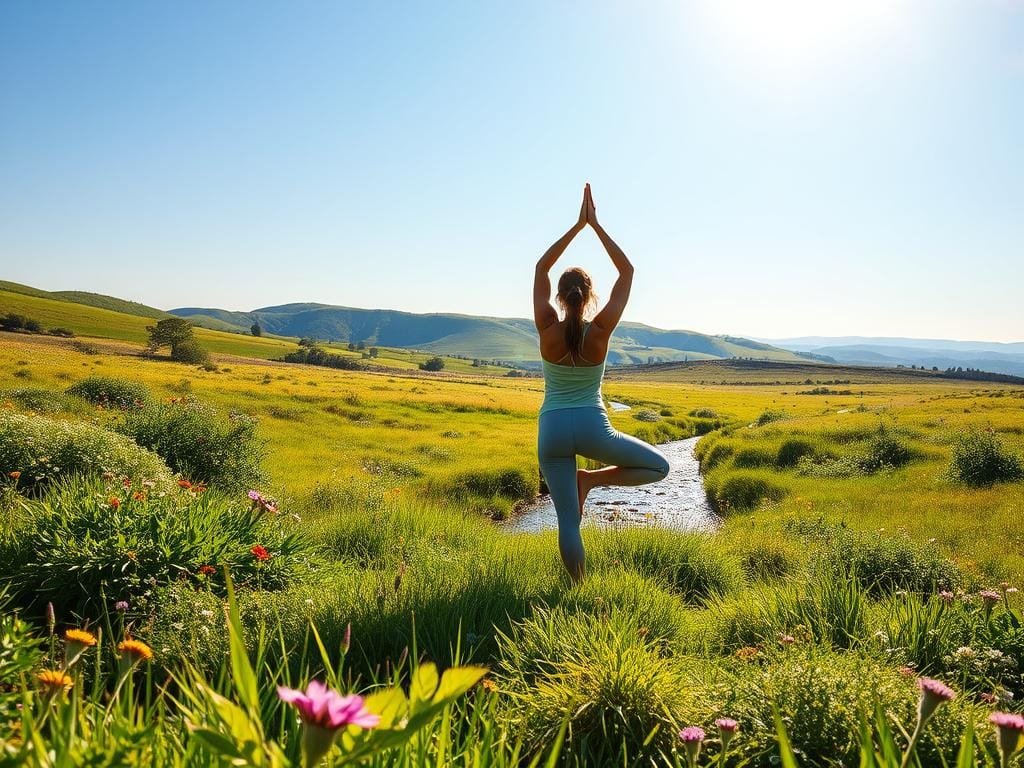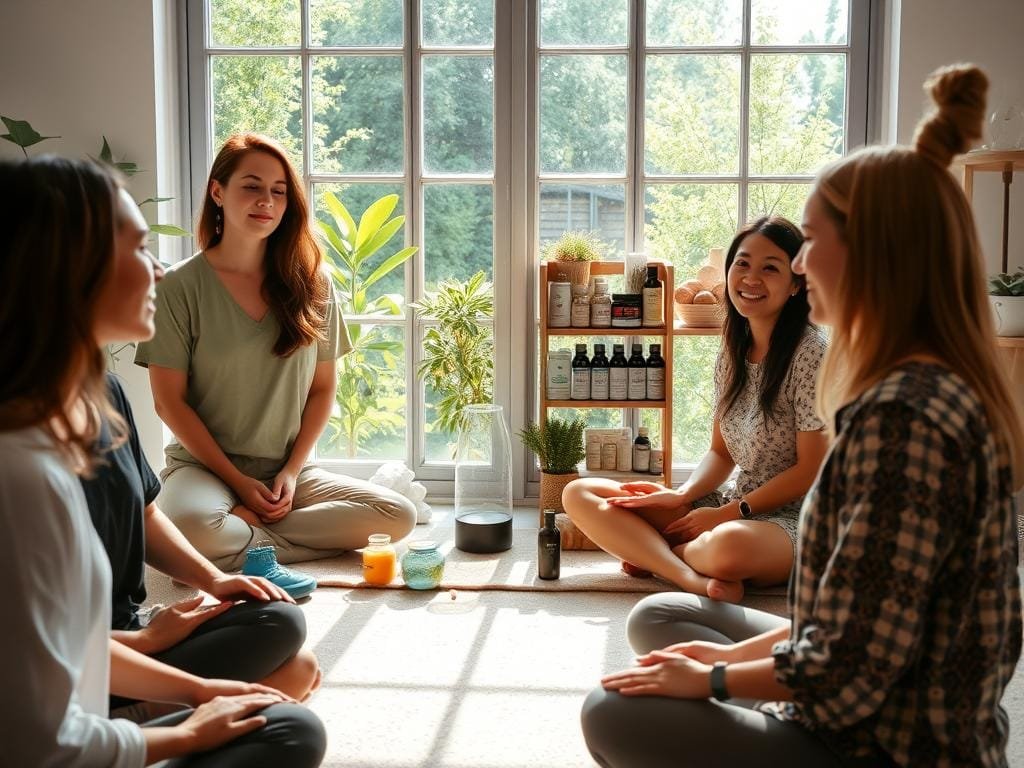Did you know a comprehensive approach to health can change your life? Embracing holistic wellness means caring for your mind, body, and spirit together. This way of health looks at how they all connect.
Choosing a holistic wellness lifestyle can lead to natural healing. It helps you find balance and harmony. This method sees you as more than just your body. It looks at your whole self – body, mind, and spirit.
Table of Contents
Key Takeaways
- Adopting a holistic approach can improve overall well-being.
- Integrative health focuses on the interconnectedness of physical, mental, and emotional health.
- Nurturing your mind, body, and spirit is key for natural healing.
- A complete approach to health aims for balance and harmony.
- Holistic wellness views you as a whole – body, mind, and spirit.
The Science and Philosophy Behind Holistic Wellness
Holistic wellness is about seeing how everything in us is connected. It looks at the balance between mind, body, and spirit. Each part affects the others.
The Three Pillars: Mind, Body, and Spirit Integration
The heart of holistic wellness is the mix of mind, body, and spirit. The mind is our thoughts, feelings, and how we think. The body is our physical health. The spirit is our connection to something bigger and our purpose.
To blend these pillars, we need a full approach that meets each person’s needs. Holistic medicine principles say this mix is key for true wellness.
Ancient Wisdom Meets Modern Research
Holistic wellness uses old wisdom and new science. Ancient healing like Ayurveda and Traditional Chinese Medicine talk about balance and harmony. New studies back these ideas by showing how our mind and spirit affect our health.
The Whole-Person Approach to Health
Seeing health as a whole is key in holistic wellness. It looks at physical health, mental state, and spiritual well-being. This way, doctors can understand and treat health better.
| Aspect of Health | Traditional Approach | Holistic Approach |
|---|---|---|
| Physical Health | Focus on treating symptoms | Consider overall physical well-being and lifestyle |
| Mental Health | Often treated separately from physical health | Integrated with physical and spiritual health |
| Spiritual Health | Not typically considered in healthcare | Recognized as a vital component of overall wellness |
Understanding the Mind-Body-Spirit Connection
The mind-body-spirit connection is key to your overall wellness and quality of life. It’s about how your mental, physical, and spiritual sides work together. This teamwork is essential for true holistic wellness.
Neurological Evidence for Integrated Wellness
Neuroscience has made big strides in understanding the mind-body link. Studies show that your brain and body are closely connected. The brain affects your physical health, and your body affects your brain.
For example, mindfulness practices improve both mental clarity and physical health.
The brain and body communicate through a network of neurons and neurotransmitters. Neurotransmitters like dopamine and serotonin help control mood and mental health.
Psychoneuroimmunology: Your Thoughts and Physical Health
Psychoneuroimmunology (PNI) studies how your mind, nervous system, and immune system interact. PNI research shows that your thoughts and feelings can greatly affect your physical health, including your immune system.
For instance, stress can weaken your immune system by reducing the activity of immune cells. On the other hand, positive emotions and stress management can boost your immune function, improving your overall well-being.
“The mind and body are not separate entities; they are intimately connected, influencing each other in complex ways.” –
The Stress Response Cycle and Holistic Balance
The stress response cycle, or fight-or-flight response, is a natural reaction to threats. It’s vital for immediate survival but can cause imbalances if it lasts too long.
| Stress Response Stage | Physiological Effects | Impact on Holistic Balance |
|---|---|---|
| Initial Response | Increased heart rate, blood pressure, and cortisol levels | Prepares the body for action, but can lead to anxiety if prolonged |
| Chronic Activation | Suppressed immune function, digestive issues, and fatigue | Disrupts holistic balance, leading to mental and physical health problems |
| Recovery Phase | Normalization of physiological responses, relaxation, and rejuvenation | Restores balance, promoting overall well-being |
Knowing about the stress response cycle is key to maintaining balance. Recognizing chronic stress and using stress management techniques can help. This way, you can reduce its negative effects and improve your overall wellness.
7 Essential Mental Wellness Practices for Holistic Living
To live a balanced life, it’s key to add mental wellness practices. These practices help build emotional strength and clear thinking. They cover stress management, brain health, and emotional smarts. Adding these to your daily life boosts your overall health and happiness.
Mindfulness Meditation for Mental Clarity
Mindfulness meditation is a great way to clear your mind and lower stress. It helps you stay in the moment, calming your thoughts and sharpening focus. Regular practice cuts down stress hormones, making you feel calm and happy.
Benefits of Mindfulness Meditation:
- Reduces stress and anxiety
- Improves concentration and focus
- Enhances emotional regulation
- Promotes better sleep
Cognitive Restructuring for Emotional Resilience
Cognitive restructuring changes negative thoughts into positive ones. This boosts emotional strength. By recognizing and changing your thoughts, you handle stress and tough times better.
Steps to Cognitive Restructuring:
- Identify negative thoughts
- Challenge these thoughts with evidence
- Replace negative thoughts with positive, realistic ones
Brain-Boosting Nutrition and Supplements
Eating right is vital for brain health. Some foods and supplements help your brain and mood.
| Nutrient | Food Sources | Benefits |
|---|---|---|
| Omega-3 Fatty Acids | Salmon, walnuts, chia seeds | Supports brain health, reduces inflammation |
| Antioxidants | Berries, leafy greens, nuts | Protects against oxidative stress |
| B Vitamins | Whole grains, lean meats, eggs | Essential for brain function and energy production |
There are four more key mental wellness practices:
- Gratitude journaling
- Engaging in creative activities
- Building strong social connections
- Practicing self-compassion
By adding these seven practices to your life, you build a stronger, more resilient mind. This improves your overall health and wellbeing.
Physical Wellness Beyond the Gym: A Complete Approach
A good physical wellness plan includes more than just gym workouts. It also covers sleep, movement, and your environment. This holistic approach boosts your overall health and life quality.

Functional Movement Patterns for Everyday Life
Functional movement is not just about exercise. It prepares your body for daily tasks. It improves strength, flexibility, and coordination.
By adding functional movements to your day, you lower injury risks. You also boost your physical abilities.
Examples of these movements are squats, lunges, and planks. They work many muscles at once. You can adjust them to fit your fitness level, making them for everyone.
Sleep Optimization Strategies for Restoration
Sleep is key for physical wellness. It lets your body fix and refresh itself. To optimize sleep, create a good sleep space, stick to a schedule, and have calming bedtime routines.
To better sleep, cut down on screen time before bed. Avoid caffeine and big meals at night. Also, make your sleep area dark and quiet. These steps help your sleep be more restorative.
Environmental Wellness and Physical Health
Your environment greatly affects your physical health. This includes both nature and your living and work spaces.
To improve your environment, make your indoor spaces healthier. Reduce pollutants, improve air, and add natural elements. Also, spending time outdoors is good for your body and mind.
Cultivating Spiritual Wellness in Modern Life
Embracing spiritual wellness can greatly improve your overall well-being. It connects you to something bigger than yourself and gives life meaning. In today’s busy world, it helps you live a more balanced and fulfilling life.
Defining Personal Spirituality Without Religious Requirements
Personal spirituality is a unique and personal experience. It’s about feeling connected to something greater, like nature or the universe. This connection brings meaning and direction to your life. It’s important to know that spirituality isn’t just about religion; it’s a wide range of beliefs and practices.
To define personal spirituality, you need to reflect and explore. You might question your values and what gives your life meaning. This helps you find a spiritual practice that truly resonates with you, regardless of your background.
5 Practices for Deepening Spiritual Connection
There are many ways to deepen your spiritual connection. Here are five practices to consider:
- Meditation and Mindfulness: Regular meditation can bring inner peace and connect you to your spiritual self.
- Nature Connection: Being in nature can inspire awe and wonder, making you feel connected to the world.
- Gratitude Practice: Focusing on gratitude can change your perspective and help you see the spiritual in your life.
- Journaling: Writing down your thoughts and insights can aid in spiritual growth and self-reflection.
- Acts of Service: Doing acts of kindness can connect you to your community and the world.
Aligning Daily Actions with Core Values
Living in alignment with your core values is key to spiritual wellness. When your actions match your values, you feel true to yourself. This leads to a more authentic and fulfilling life.
To align your actions with your values, first identify what matters most to you. Think about what you stand for and believe in. Once you know your values, make choices that support them. This might mean setting boundaries, making big changes, or being more mindful in your daily life.
Holistic Wellness Through Nutritional Intelligence
Nutritional intelligence is key to holistic wellness. It helps you choose the right foods for your body and mind. By knowing how nutrition affects health, you can use whole foods to improve your well-being.

Whole Foods as Medicine for Mind and Body
Whole foods are the base of a healthy diet. They give your body and mind the nutrients they need. Eating a variety of whole foods can prevent diseases and boost your health. Make sure to eat a rainbow of fruits and vegetables, whole grains, lean proteins, and healthy fats.
Studies show that some whole foods are great for your mental health. Foods like salmon and walnuts, rich in omega-3s, support your brain. Fermented foods, like yogurt and kimchi, are full of probiotics that help your gut and mind.
The Anti-inflammatory Diet Blueprint
Many diseases, like heart disease and diabetes, are caused by chronic inflammation. An anti-inflammatory diet, full of whole foods and antioxidants, can fight this. Key foods include leafy greens, berries, nuts, and fatty fish, all packed with antioxidants and omega-3s.
- Leafy greens like spinach and kale
- Berries such as blueberries and raspberries
- Nuts and seeds, including almonds and chia seeds
- Fatty fish like salmon and sardines
Mindful Eating Practices for Digestive Harmony
Mindful eating can change how you view food and improve digestion. It involves listening to your hunger and fullness, enjoying each bite, and eating slowly. This can help with digestion and reduce digestive problems.
To practice mindful eating, try to avoid distractions like TV or phones during meals. Instead, focus on the taste, texture, and smell of your food. This approach not only aids digestion but also strengthens your relationship with food.
Energy Medicine and Alternative Healing Approaches
Energy medicine and alternative healing offer a complete way to understand and boost your well-being. They focus on the subtle energies in and around the body. This helps bring balance and harmony.
Traditional Energy Systems: Ayurveda, TCM, and Reiki
For centuries, traditional energy systems have helped people stay healthy. Ayurveda, from India, aims to balance three doshas (Vata, Pitta, and Kapha) for physical and mental health. Traditional Chinese Medicine (TCM) works on the flow of Qi, or life force, through the body’s meridians. Reiki, from Japan, uses universal life energy for healing and relaxation.
- Ayurveda: Balancing the doshas through diet, lifestyle, and herbal remedies.
- TCM: Restoring Qi balance through acupuncture, herbal medicine, and Qi Gong.
- Reiki: Practicing hands-on or distant healing to enhance energy flow.
Modern Energy Healing Modalities in America
In America, modern energy healing combines old and new techniques. Some popular ones include:
- Qigong: Mixing movement, breathwork, and meditation to balance Qi.
- Pranic Healing: Using the body’s energy field to remove negative energies and improve well-being.
- Healing Touch: A biofield therapy that uses touch to affect the human energy system.
Finding Qualified Energy Medicine Practitioners Near You
To find a good practitioner, follow these steps:
- Research local practitioners and their credentials.
- Read reviews and testimonials from previous clients.
- Ask for referrals from healthcare professionals or friends.
- Check if the practitioner is certified by a reputable organization.
Exploring energy medicine and alternative healing can add to your holistic wellness. It can also improve your overall well-being.
Designing Your Personalized Holistic Wellness Plan
Creating a holistic wellness plan means looking into your strengths, challenges, and dreams. This personal touch makes your wellness journey fit just right for you. It makes it more effective and lasting.

Self-Assessment Tools for Mind-Body-Spirit Balance
The first step is to do a self-assessment. This means checking how you’re doing in mind, body, and spirit. Use wellness questionnaires, journaling, or talk to wellness experts to understand your well-being.
These tools help spot your strengths and areas to improve. Mindfulness shows your mental toughness, while physical checks tell you what your body needs.
Setting SMART Wellness Goals Across All Dimensions
After knowing where you stand, set SMART wellness goals. These goals should cover your mental, physical, and spiritual health. This ensures a well-rounded approach.
- Mind: Improve mental clarity through daily meditation practices.
- Body: Enhance physical health by adopting a balanced diet and regular exercise routine.
- Spirit: Deepen spiritual connection through weekly nature walks and gratitude practices.
SMART goals give you a clear path for your wellness journey. They help you see your progress and stay on track.
Adapting Your Plan Through Different Life Stages
Life changes, and so should your wellness plan. It should adjust to career shifts, health issues, or personal growth. Your plan should always meet your current needs.
Keep revisiting and updating your wellness plan. This might mean changing your goals, trying new practices, or getting help from wellness coaches. This way, your plan stays relevant and effective.
By being flexible, you can keep your wellness journey balanced and fulfilling at every life stage.
10 Ways to Integrate Holistic Practices into Your Daily Routine
Adding holistic practices to your daily life can greatly improve your well-being. It’s about taking care of your mind, body, and spirit. Simple practices can lead to a balanced and fulfilling life.
Morning Rituals for Mind-Body-Spirit Alignment
Starting your day with mindfulness can set a positive tone. Try a 10-minute meditation or some stretching exercises. Wellness experts say meditation is about watching your thoughts, not stopping them.
Adding a morning routine with journaling or deep breathing boosts mental clarity. It prepares you for the day’s challenges.
- Practice a 5-minute morning meditation
- Engage in some light physical activity, like yoga
- Write down three things you’re grateful for
Workplace Wellness Strategies for the Modern Professional
Staying well at work is key, even with tough jobs. Short breaks to stretch or deep breathing exercises can lower stress. Wellness experts say breaks boost productivity and prevent burnout.
Using a standing desk or organizing your space can also help. It promotes better posture and comfort.
- Take a 5-minute walk every hour
- Use ergonomic furniture to reduce physical strain
- Limit screen time and follow the 20-20-20 rule
Evening Practices for Restoration and Renewal
Relaxing evening activities signal to your body it’s time to rest. Reading, a warm bath, or gentle stretches are good. Experts say a bedtime routine improves sleep quality.
Avoid screens for an hour before bed. Create a calm space for better sleep.
- Dim the lights to signal the body that it’s time to sleep
- Avoid caffeine and heavy meals close to bedtime
- Engage in a relaxing activity, like listening to soothing music
By adding these holistic practices to your day, you can live a healthier life. Begin with small steps and build up for lasting wellness.
Finding Professional Support for Your Holistic Wellness Journey
As you explore holistic wellness, finding the right professionals is key. Holistic wellness aims to balance the mind, body, and spirit. Getting help from skilled holistic health practitioners is very helpful.

Types of Holistic Health Practitioners in the United States
The United States has many holistic health practitioners. These include:
- Naturopathic Doctors (NDs)
- Acupuncturists and Traditional Chinese Medicine Practitioners
- Yoga and Meditation Instructors
- Nutritionists and Dietitians specializing in holistic nutrition
- Massage Therapists and Bodyworkers
- Energy Healers, such as Reiki Practitioners
Each professional offers unique support for your wellness journey. For example, a visit to a holistic wellness center can introduce you to various practitioners. They can customize their services to fit your needs.
Vetting Questions for Choosing the Right Practitioner
When picking a holistic health practitioner, ask the right questions. Here are some to consider:
| Question | Purpose |
|---|---|
| What qualifications and certifications do you hold? | To verify their expertise and legitimacy. |
| What experience do you have in holistic health practices? | To understand their background and effectiveness. |
| How do you tailor your practice to individual needs? | To ensure they can meet your specific wellness goals. |
Creating an Integrated Healthcare Team
An integrated healthcare team combines doctors with holistic practitioners for full care. To build such a team, follow these steps:
- Begin with your primary care doctor and talk about holistic wellness.
- Find holistic practitioners who match your wellness goals.
- Make sure all team members agree on your care plan.
By doing this, you create a supportive environment for your well-being.
Overcoming Common Obstacles on Your Holistic Wellness Path
Starting your holistic wellness journey can face many challenges. It’s important to know these obstacles and find ways to beat them. This keeps you moving forward.
Addressing Skepticism from Family and Healthcare Providers
Family and healthcare providers might doubt your holistic wellness choices. This doubt often comes from not understanding or believing in holistic practices. To change this, teach them about the scientific basis and personal benefits of what you’re doing.
Sharing success stories or research can help. For example, if you meditate, show them studies on its mental health benefits. Invite them to try it with you so they can see the benefits for themselves.
Navigating Information Overload and Contradictory Advice
There’s a lot of info on holistic wellness, which can be overwhelming. It’s easy to get lost in conflicting advice. Stick to credible sources and evidence-based practices. Look for advice from trusted experts in holistic wellness.
For tips on managing info overload, check out this article on overcoming obstacles in achieving overall wellness. It offers insights on finding reliable advice.
Maintaining Consistency During Life Transitions
Life changes, like moving or getting a new job, can upset your wellness routine. To stay consistent, be flexible and adaptable. Keep the core of your wellness practice the same, but adjust it to fit your new life.
- For example, if meditation is key, find a new quiet spot at home or try guided meditations on the go.
- If yoga is important, look for online classes or a new studio near you.
Being proactive and flexible helps you keep your wellness commitment during life’s ups and downs.
Conclusion: Embracing the Lifelong Journey of Holistic Wellness
Holistic wellness is a lifelong journey that needs constant effort and commitment. It’s about taking care of your mind, body, and spirit. This journey is about making your life better in every way.
By starting this journey, you’re not just improving your health now. You’re also setting yourself up for a future full of energy and strength. Your path to wellness is unique, so be kind to yourself as you face different challenges.
Every small step you take towards wellness helps a lot. It could be practicing mindfulness, eating better, or finding spiritual connection. Each step brings you closer to being whole and balanced.
Keep being open to new things as you continue your wellness journey. Don’t be afraid to ask for help when you need it. This way, you can stay on track and overcome any hurdles, living a life that truly nourishes you.

